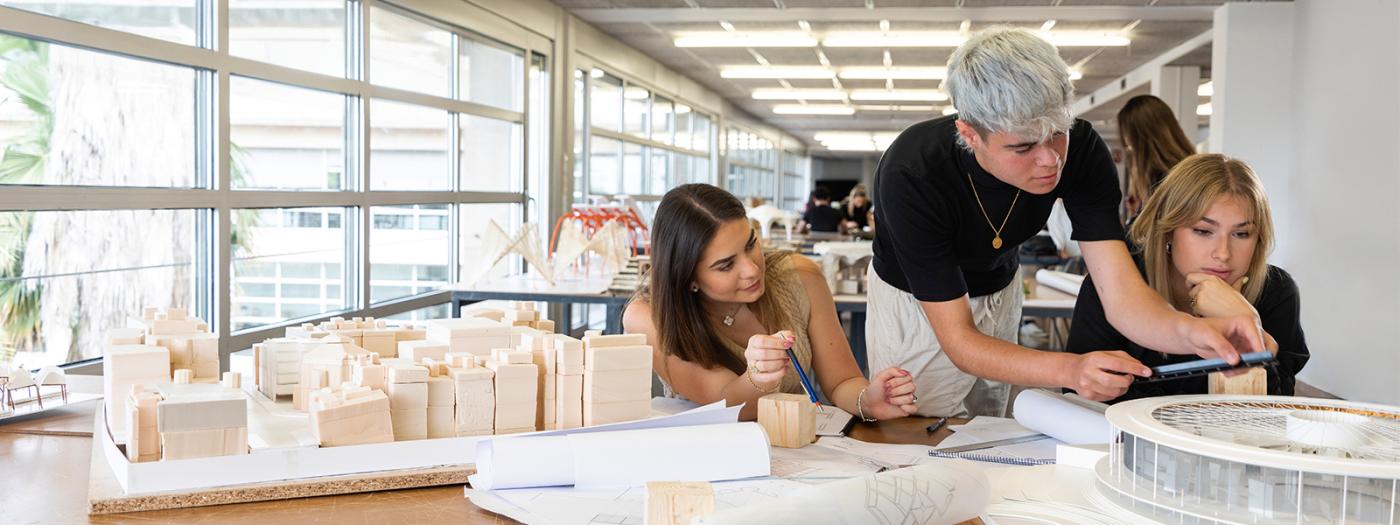Titular Professors
Basic Algebra
Learning Outcomes of this subject are:
R1. Understanding of the formulation of mathematical models (development of the abstraction faculty / understanding of mathematical models)
R2. Ability to apply the theoretical knowledge acquired to solving practical problems (development of strategies for problem solving / function analysis)
R3. Ability to interpret and check mathematical results.
R4. Ability to establish relationships between symbolic, analytical, and graphic representations.
The subject has a weekly operation with two class sessions.
Each session is divided into three parts: a first is dedicated to solving problems carried out by the students at home, a second part in which the teacher explains the new content (seminar, flipped classroom, peer instructions) and a third in which students work on new exercises to consolidate the matter.
Every two or three sessions, individual or group evaluation activities are carried out through written tests, online questionnaires, collection of exercises carried out at home, etc.
There are also gamification activities (Socrative, Kahoot) where students get bonuses that they can use during official assessments.
The final grade of the subject will be the average of the two semester final grades.
The minimum grade for averaging between semester grades is 4.
In order to assess whether the student has achieved the learning outcomes pursued in the subject to an adequate degree, different evaluation activities are used (with a frequency approx. weekly).
The following table shows the percentage of evaluation of each activity on the final grade:
CONTINUOUS EVALUATION SYSTEM:
R1 30% 5% ACTIVITY IN CLASS (TEST, QUESTIONNAIRE, HOMEWORK, ETC.)
5% ACTIVITY IN CLASS (TEST, QUESTIONNAIRE, HOMEWORK, ETC.)
5% ACTIVITY IN CLASS (TEST, QUESTIONNAIRE, HOMEWORK, ETC.)
15% FINAL ACTIVITY
R2 30% 5% ACTIVITY IN CLASS (TEST, QUESTIONNAIRE, HOMEWORK, ETC.)
5% ACTIVITY IN CLASS (TEST, QUESTIONNAIRE, HOMEWORK, ETC.)
5% ACTIVITY IN CLASS (TEST, QUESTIONNAIRE, HOMEWORK, ETC.)
15% FINAL ACTIVITY
R3 30% 5% TEAMWORK
5% ACTIVITY IN CLASS (TEST, QUESTIONNAIRE, HOMEWORK, ETC.)
5% ACTIVITY IN CLASS (TEST, QUESTIONNAIRE, HOMEWORK, ETC.)
15% FINAL ACTIVITY
R4 10% 5% TEAM PROJECT (Algebra)
5-10% Aula Barcelona: Algebra (5%), Calculus (10%)
The student can benefit from continuous assessment (Ordinary Call) if he/she has completed at least 90% of the different activities.
If the student is unable to do any activity for a justified reason, depending on the % of the activity, the student will not be taken into account for the evaluation:
- 5% will not be taken into account for the evaluation (it will not be recovered) distributing the % in the other activities.
- 15% will be made up on a date to be agreed with the teachers.
The minimum mark for the R is 4. In case of having a semester grade lower than 4, the final grade of the subject will be the grade of the semester not approved.
If students do not participate in Aula Barcelona (because it has already been taken) the % of this activity will be distributed among the other activities.
Students who do not pass the Ordinary Examination will have an Extraordinary Examination in July in which they will be able to recover the different semesters (or both if necessary). The teachers will assess whether an oral interview is also necessary.
Students who do not sit any of the resit exams will have a final mark of NP (Not Presented) in the extraordinary exam.
Minimum requirements for the student to benefit from continuous assessment (Ordinary Call):
- the sum of the evaluation % of all the activities must be 90%
- the minimum mark in each of the final evaluation activity (15%) ≥ 3.
If the student cannot carry out an activity for a justified reason, depending on the % of the activity:
- 5% will not be taken into account for the evaluation (it will not be recovered) distributing the % in the other activities
- 15% will be recovered in the Ordinary Call (January/May)
If students do not participate in Aula Barcelona (because it has already been taken) the % of this activity will be distributed among the other activities.
Students who do not pass the Ordinary Examination will have an Extraordinary Examination in July in which they will be able to recover the different semesters (or both if necessary). The teachers will assess whether an oral interview is also necessary.
1st SEMESTER: LOGIC OF THE SPACE (LINEAR ALGEBRA)
1. SPACE REPRESENTATION
1.1 Systems of linear equations
1.2 Linear combination and linear independence of vectors
1.3 Vector spaces and subspaces
1.4 System of generators and bases
1.5 Operations of vector sub spaces
1.6 Inner vector spaces
2. LINEAR TRANSFORMATIONS
2.1 Types of transformations
2.2 Characterization
2.3 Change of basis
2.5 Eigenvectors and eigenvalues of an endomorphism
3. RESOLUTION OF CONICS AND QUADRICS
3.1 Quadratic forms in geometry
3.2 Classification of conics and quadrics
2ND SEMESTER: BIG DATA (CALCULUS)
1. MATHEMATICAL MODELS
1.1 Real function of real variable: domain and image, growth and decrease, symmetry, periodicity, dimensions.
1.2 Elementary functions
2. INTERPRET AND SKETCH MATHEMATICAL RESULTS
2.1 Structures application
2.2 Optimization problems
2.3 Areas
2.4 Surfaces of revolution
3. BIG DATA
3.1 Data
3.2 Measures of centrality and dispersion
3.3 Quantiles and measures of form
3.4 Statistics in more dimensions
3.5 Linear regression models
